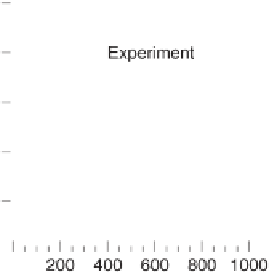Biology Reference
In-Depth Information
Figure 9.4
Model versus experimental action potentials and Ca
2+
transients.
Each action potential and Ca
2+
transient is in response to a 1 Hz pulse train,
with responses measured in the steady-state. (a) Experimentally measured
membrane potential (mV, ordinate) as a function of time (ms, abscissa) in
normal (solid) and failing (dashed) canine myocytes. (b) Experimentally
measured cytosolic Ca
2+
concentration (nmol/l, ordinate) as a function of time
(ms, abscissa) for normal (solid) and failing (dashed) canine ventricular
myocytes. (c) Membrane potential (mV, ordinate) as a function of time (ms,
abscissa) simulated using the normal canine myocyte model (solid) and failing
(dashed) canine myoycte model (end-stage heart failure modeled by down-
regulation of
I
to1
by 66%, downregulation of
I
K1
by 32%, downregulation of
SERCA2 by 62%, and upregulation of NCX1 by 75%). (d) Cytosolic Ca
2+
concentration (nmol/l, ordinate) as a function of time (ms, abscissa) simulated
using the normal (solid) and heart failure (dashed) model.
to the last stimulus of this periodic pulse train. Following cessation of
the periodic stimulus train, a second stimulus (denoted S2) is delivered
at a variable interval. Responses labeled
a
and
b
in figures 9.5a-b are
Ca
2+
and force transients in response to short or long S2 intervals,
respectively, following cessation of the periodic pulse train. A third

















































Search WWH ::

Custom Search